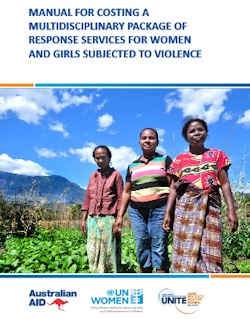
Manual for Costing a Multidisciplinary Package of Response Services for Women and Girls Subjected to Violence

Violence against women (VAW) is one of the most systemic and widespread human rights violations in the world. In Asia and the Pacific, as around the world, it affects individuals regardless of context, culture, or socio-economic status, with serious repercussions for women, their families, and societies. Despite significant progress, including in the area of legal and policy reforms, research, and a number of awarenessraising campaigns, the prevalence of VAW across the Asia-Pacific region remains high. There is also widespread impunity for perpetrators and limited access to justice and support services for survivors.
Governments have a human rights obligation to prevent and respond to VAW in their countries. Passing laws and policies that define and appropriately criminalize such violence as a human rights violation is important, as is ensuring access to services for survivors under these laws and policies. Yet for such services to be implemented effectively and seamlessly, they also need to be adequately funded. Too often, this is not the case.
Budgeting any government activity is both technical and highly political. A government’s budget reflects priorities influenced by the political and socio-economic situation of any given country. Budgets are one of the most important statements a government can make regarding priorities, and efforts should be made to evaluate the impact they have on citizens’ lives.
Like budgeting, costing VAW is also both technical and political. There is a need to clarify the overall cost of VAW to the state (and indeed to the whole of society), but also to understand the specifics required to ensure an adequate response to address the problem, and how to budget for and fund each strategy or service appropriately. While there has been a great deal of progress in developing laws and policies to address VAW, lack of effective and adequate costing of those policies are in many cases hindering their effective implementation. Given the harsh fiscal realities facing governments everywhere, these analytical exercises can help governments and other stakeholders working on VAW to discern and prioritize the services most critical for adequately and efficiently addressing VAW in a particular community.
Costing is an emerging area of research within efforts to address and prevent VAW, whereby researchers and advocates are working to measure the economic impact of such violence, from both a specific financial point of view (unit costing) and a broader societal perspective (impact costing).